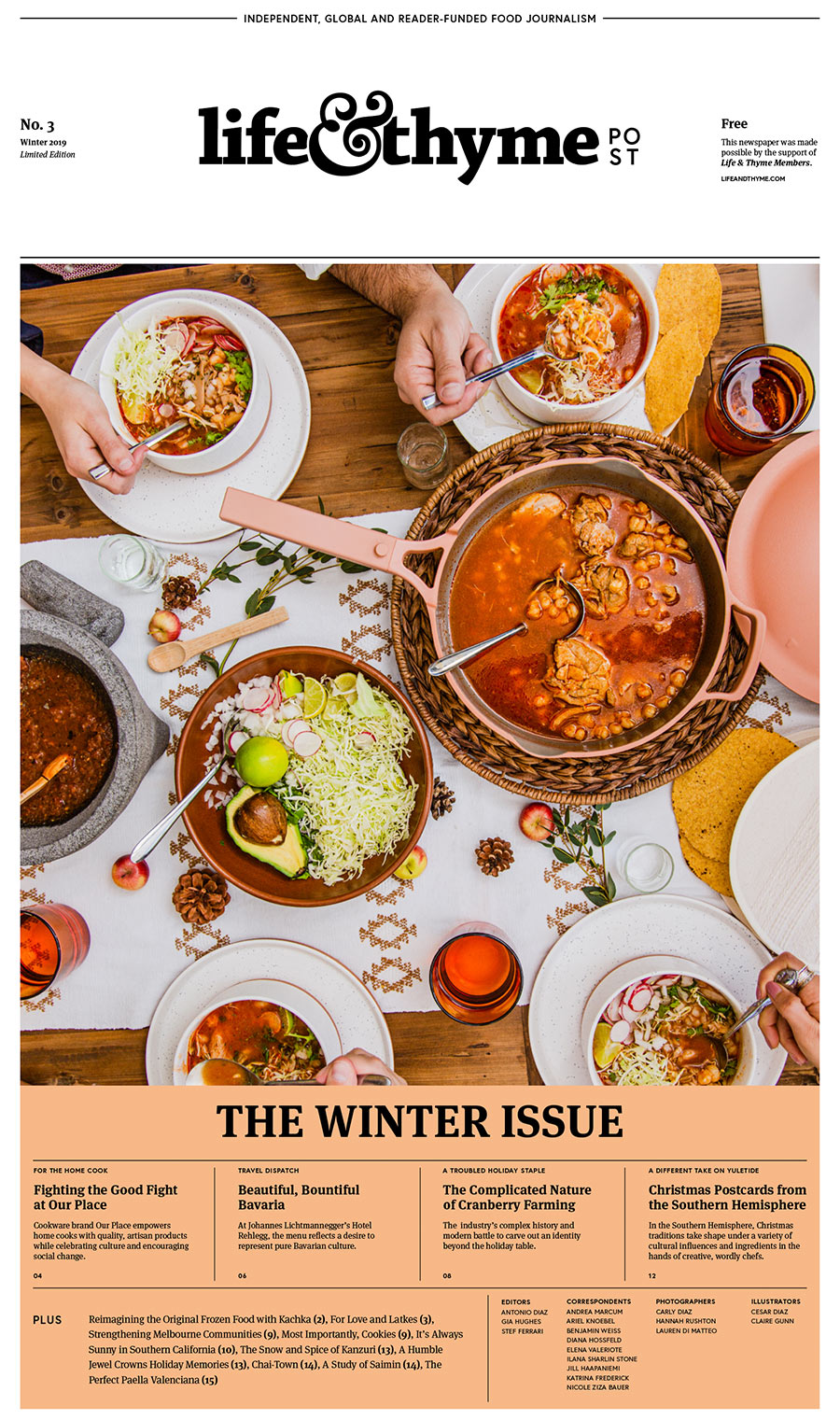Dec. 20, 2019 — The Winter Issue
The Complicated Nature of American Cranberry Farming
The cranberry industry’s complex history, and modern efforts battle to carve out an identity and market beyond the holiday table.
Words and illustration by Ariel Knoebel


This story can also be found in The Winter Issue of Life & Thyme Post, our limited edition printed newspaper for Life & Thyme members.
Cranberries embody the spirit of hearty New Englanders through and through. They have evolved under unpredictable seasons and harsh conditions of the Northern Atlantic coast. They grow best in soil unfit for cultivation of much else, boggy land too full of water but lacking in oxygen. Their fragile spring vines survive a hard frost by hunkering down under a layer of ice, courtesy of farmers who flood their fields to insulate the plants’ roots under a frozen blanket. They are tart, difficult for some people to understand, but warm them up, perhaps sweeten the pot a bit, and cranberries will burst right open and show you a side you may never have otherwise known.
The sandy bogs of Cape Cod, Massachusetts, are often considered the home of the American cranberry. The native American fruit was first cultivated there in the early 1800s after growing wild for hundreds of years. Sailors brought cranberries on sea voyages to help stave off scurvy. Like so many other berries, cranberry season is a short shock of color, with a mere six weeks to harvest as many as possible before the frost comes and puts the vines to sleep for the winter. Instead of early June, when strawberries swell against the pastels of spring, or the sweet promise of summer blueberries that kicks off July, cranberry season occurs in the fall. Their harvest happens when people are beginning to turn indoors, wrapping themselves in sweaters and hunkering down for their own winter dormancy. Because of that, they are often forgotten until they appear in sauce form, be it chunky and citrus studded or in thin slices still shaped like the can from which it came.
To imagine this fruit can only satisfy this singular role is a shame, because in each of those strange, tart little berries is a strange story of a uniquely American commodity crop, the business of selling holiday nostalgia year-round, and a hearty underdog of the culinary world.
While Massachusetts started American cranberry cultivation, growing quickly spread to Wisconsin (the leading cranberry growing region in the U.S. today), New Jersey, and into the Pacific Northwest. The cranberry became a cash crop, a way for farmers in boggy climate with acidic soil to turn land profitable.
During this time of expansion, cranberry growers began to organize into cooperatives to help centralize marketing and distribution. Wisconsin farmers created the Cranberry Growers Union in the 1890s, and pooled their crop—and their profits—to distribute as a cooperative. Eventually, the Wisconsin cooperative merged with similar regional groups in Massachusetts and New Jersey to create the American Cranberry Exchange. This model of growing and distribution would come to define the cranberry industry.
In 1912, Massachusetts lawyer-turned-cranberry-farmer Marcus Urann began to cook and can cranberries under the name Ocean Spray Preserving Company. This allowed him to stretch sales all year, as well as utilize less than perfect fruit that would not have sold fresh. The idea was a success, and two of the country’s largest growers merged with Urann to create Cranberry Canners, Inc. By 1937, they canned their one millionth cranberry sauce, which ended up on President Roosevelt’s Christmas dinner table. Cranberry Canners, Inc. evolved into the National Cranberry Association in 1946, which became Ocean Spray Cranberries in 1957. Ocean Spray has since grown into the industry’s primary cooperative, supplying about eighty percent of the world’s cranberries.
Ocean Spray’s success in processed cranberry products was not always welcomed across the industry, however. The American Cranberry Exchange’s Eatmor brand focused on the grading and sale of high quality fresh cranberries. During the first half of the twentieth century, these cooperatives were fighting over the marketing identity of the cranberry; would it be a fresh, seasonal product well known to the home cook, or a processed, dried or canned product with many easy uses? By 1950, processed cranberry consumption outpaced fresh.
The cranberry industry was always volatile, but it experienced a remarkable downturn in 1959 when the American government announced a small portion of the cranberry crop in the Northwest had been treated with aminotriazole, a pesticide discovered to cause abnormal growth in lab rats. Due to the collective nature of cranberry processing, it would be impossible to know where those cranberries had ended up, and if they were in the can of sauce destined for any given Thanksgiving table. America’s own berry was rejected by the country during the holiday time it typically shines, and even the First Family chose applesauce as a fruit accompaniment to their turkey that year. Cranberry sales totaled close to zero that fall. Following the crash, the Cranberry Marketing Committee was created in 1962 by a Federal Marketing Order to “ensure a stable, orderly supply of good product.” They instituted the first set aside, or mandated disposal of a portion of the crop, to help balance out pricing in the market.
By the 1990s, the cash value of cranberries rose considerably. Cranberry juice cocktail and other cranberry juice mixes gained popularity, partially because of a highly reported study linking cranberries to prevention of urinary tract infections, and the reputed health benefits were only becoming more pervasive. In 1993, Craisins appeared on the market, further increasing berry sales during the juice boom. And it certainly didn’t hurt that after its premier in 1998, Carrie Bradshaw and her friends on the hit TV show Sex and the City could reliably be found with a cosmopolitan in hand, offering the cranberry cocktail as an aspirational accessory for the everyday American woman.
Farming, however, is a difficult market for trend predicting. It is not so simple to increase production; it requires installing irrigation, buying new land, and planting new crops. Cranberry vines don’t reach full maturity for five to seven years. Predictably, the boom of the 1990s lead to a market crash in the early 2000s. The CMC reinstituted set-asides for two years to try to balance out the market, meaning farmers were destroying crops they had grown in hopes of repaying the cost and labor of expanding their farms to ramp up production.
Today, the cranberry market continues to struggle. In 2017, cranberry growers were mandated to set aside fifteen percent of their yield. Last year, it was twenty-five. That means they were required to destroy one of every four berries grown, or divert them to charity, research or foreign sales. Due to better technology and new crop species, cranberry yields are growing year to year (from eight million barrels in 2012 to 9.6 million in 2016, according to the USDA), but the market demand has not kept up with supply. So, year over year, cranberry growers are left with surplus inventory in storage before they’ve even begun their next planting.
The strange part of the set aside, however, is that the surplus inventory isn’t really cranberries. It’s cranberry juice concentrate. The cranberry juice craze of the 1990s still haunts the market, which built itself up to provide concentrate for consumers who no longer want the juice. Cranberries, by nature, are sour. Most of the juices on grocery store shelves have historically included a fair amount of sugar to balance out their flavor. As shoppers have become more health conscious and sugar has evolved into a dietary villain, the future of shelf-stable cranberry juice doesn’t look promising, and it may continue to drag down the cranberry market as a whole.
Brendan Moquin, an independent farmer who also manages a cold-pressed cranberry juice brand, Blue Water Farms, sees the set aside as an unfortunate suppression of the cranberry market. “The set aside didn’t affect me at all, because I deal with primarily the sale of whole frozen cranberries which are in a shortage compared to shelf stable concentrate, which is in a surplus.” The oversupply of cranberry juice concentrate could be costing cranberry farmers, regardless of where their crops end up, because the price per barrel continues to stay low as long as supply outpaces demand.
The CMC continues to try to balance supply and demand for cranberries proactively with new product development and consumer education. Today, ninety percent of cranberries are harvested for production rather than sale as fresh, whole berries. While the original intention of processing cranberries was to offer the American public more ways to enjoy them, in many ways it has served to alienate the American people from the nature of the whole fruit, and in some ways narrowed the success of the cranberry market.
“There’s such a weird refusal to accept the cranberry as a fresh berry,” says Erica Wides, chef, culinary instructor, writer and host of Funny People Making Food. Wides is a native Northeasterner with a sweet spot for this tart berry. “I love to stick up for the underdog foods, the things that people just dismiss. There’s a lot more out there than just the four basic species we tend to eat,” she says, extolling the nutritional benefits of the cranberry. She suggests thinking of the cranberry as the acidic component in cooking or baking throughout the year. She notes there’s a big difference between the fragrant acidity of citrus and the aggressive tartness of cranberries, but suggests that “nutritionally speaking, you’re getting a lot more value from throwing in a handful of fresh cranberries than you are from squeezing a little lemon juice in something.”
Wides also suggests adding cranberries to summer baking, using their tartness to balance out the silky sweetness of stone fruits in pies, or chopping them raw into salads and relishes in the winter when fresh when tomatoes and strawberries are unavailable. Beyond canned sauce, the cranberry offers an opportunity to go on a culinary exploration, and a way to support a struggling American industry while doing so.
The pop of boiling cranberries on the stove, thickening around lacy orange peel and anise stars, the fragrant steam warming the crisp late-autumn air, is one of my favorite parts of holiday cooking. The business of cranberry farming, however, is as harsh as the conditions in which the hearty plants grow. The farmers, like their crop, are working through challenges in an environment with too few resources and generations of adversity to navigate. Somehow, they continue to survive each time they are flooded, even to float through the icy waters and thrive.






Our comments section is for members only.
Join today to gain exclusive access.